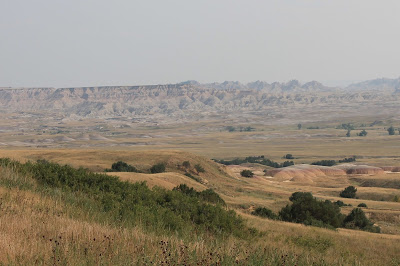 |
| Our last day, so let's go see some snakes, crocs and gators. |
 |
| First stop, petting a python. Easy peasy, just don't touch its head. Apparently, snakes don't like that. |
Badlands National Park, South Dakota - 16 August 2018
 |
| The haze from the wildfires to the north and west of South Dakota takes away the colors of the spectacular views. |
 |
| The Badlands Wilderness Area serves as a reintroduction site for bison. |
 |
| Every which way we turned was a contrast from jagged peaks to rolling rocky hills with grass interspersed. |
 |
| The different colors still can't be seen as clearly in photography. |
 |
| Do you see a face in this profile? |
 |
| The flat surfaces are called tabletops. |
 |
| Finally, we can see the striations of different eras. |
 |
| I made it down the overlook with multi-level sculpted spires that rise from the plains at the Door Trail. |
 |
| The above ground portion of the Delta-01 Control Center dining room. This Control Center had a 24-hour crew to work the launch control building 30 feet underground. |
 |
| Part of the crew included a cook. But if you didn't want what was on the menu, he would heat up a ubiquitous frozen TV dinner. Bon appetit. |
 |
| The above ground Security Station. Pay attention to the 1990 phones and intercom system. |
 |
| Intercontinental Ballistic Missiles (ICBMs on the left) were launched above ground because they were liquid fueled. The Minuteman was a solid fuel missile and could be launched from underground. |
 |
| The blast door to the underground. USAF personnel just having a little fun. Notice there is no handle on the outside of the door. Access is only allowed from the staff inside. |
 |
| This door was kept closed except for the cook bringing meals or a change in the two staff members monitoring the 10 missile sites assigned to this "flight". |
 |
| This is one of four shock absorbers that are built into the underground chamber to make sure earthquakes do not disrupt the monitoring crew. |
 |
| What a throw back. |
 |
| Bob practicing the fateful "key turn" at the Visitor's Center Museum. |
 |
 |
| Under this dome is a dummy missile left in place. |
 |
| The dummy missile is shown connected to the umbilical cord which is a direct cable to the Launch Control Facility. |
 |
| The museum tells the story of the Massacre at Wounded Knee. The artifacts that were gathered from the site have been returned to the Lakota people. |
 |
| The Feather Display symbolizes those who perished at Wounded Knee Creek. Men, women and children. |
 |
| The Memorial is located at the site of the attack while the names of the victims are etched into these acrylic disks. |















No comments:
Post a Comment